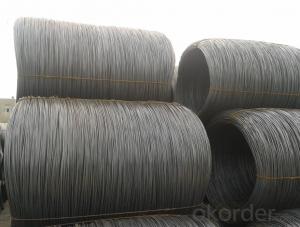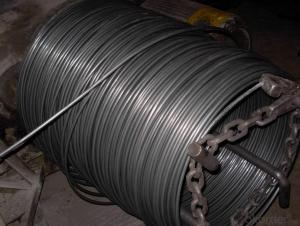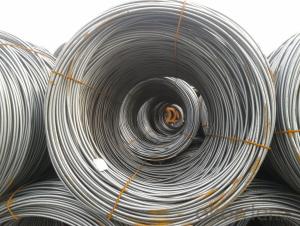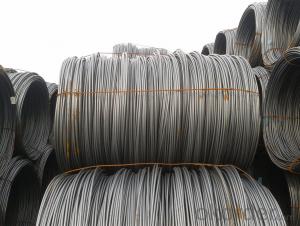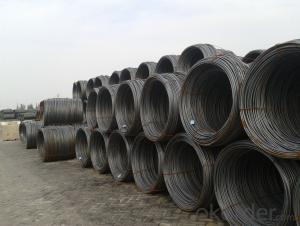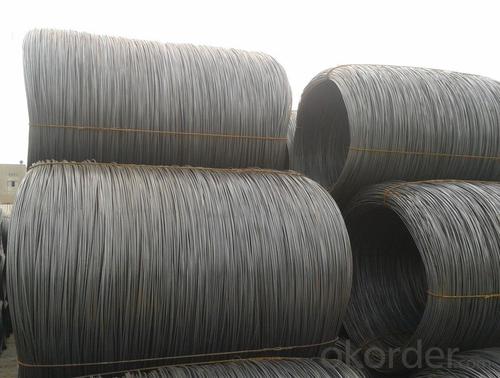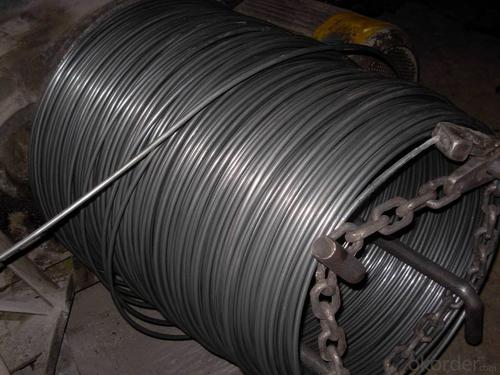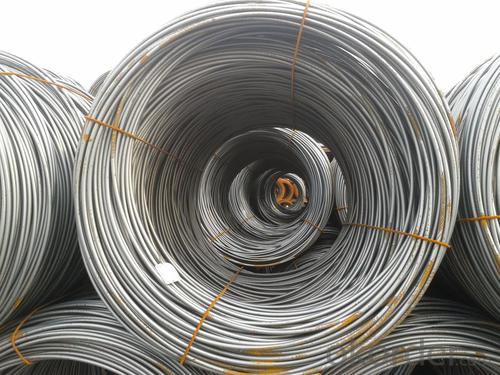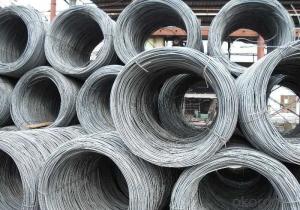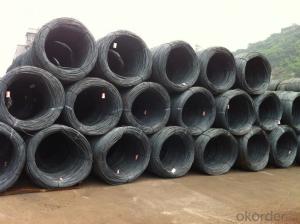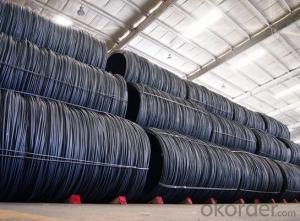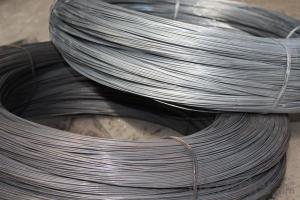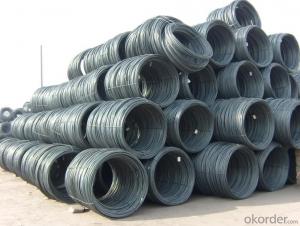SAE1006Cr Carbon Steel Wire Rod 12.5mm for Welding
- Loading Port:
- Shanghai
- Payment Terms:
- TT OR LC
- Min Order Qty:
- 100 m.t
- Supply Capability:
- 30000 m.t/month
OKorder Service Pledge
OKorder Financial Service
You Might Also Like
Specification
Description of SAE1006Cr Carbon Steel Wire Rod 12.5mm for Welding:
OKorder is offering Color Coated Steel Coil Prepainted Steel Coil at great prices with worldwide shipping. Our supplier is a world-class manufacturer of steel, with our products utilized the world over. OKorder annually supplies products to European, North American and Asian markets. We provide quotations within 24 hours of receiving an inquiry and guarantee competitive prices.
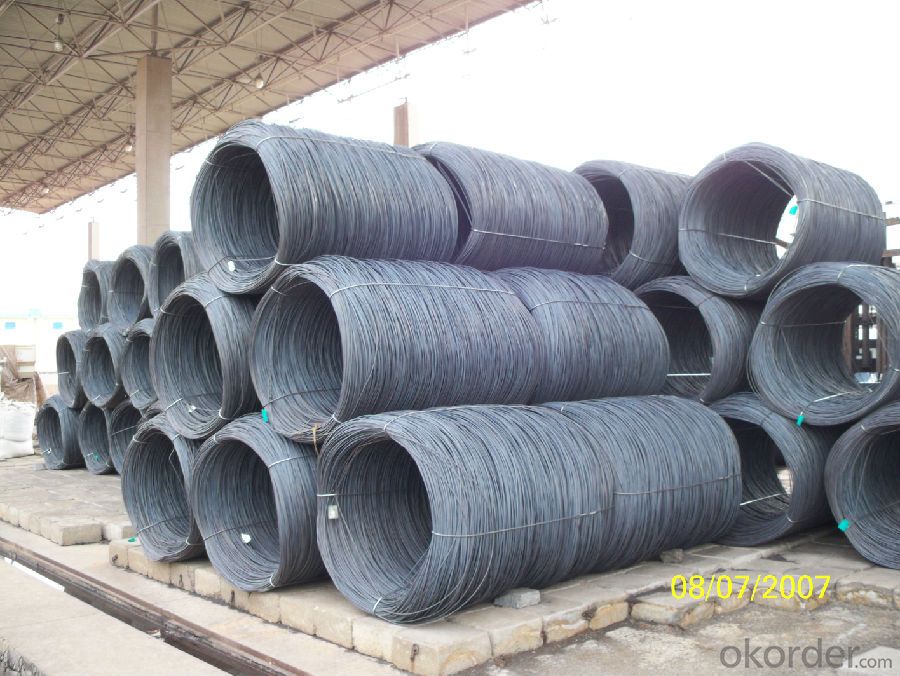
Applications of SAE1006Cr Carbon Steel Wire Rod 12.5mm for Welding:
Color Coated Steel Coil Prepainted Steel Coil are ideal for structural applications and are widely used in the construction of buildings and bridges, and the manufacturing, petrochemical, and transportation industries.
Main Product Features of SAE1006Cr Carbon Steel Wire Rod 12.5mm for Welding:
· Premium quality
· Prompt delivery & seaworthy packing (30 days after receiving deposit)
· Corrosion resistance
· Can be recycled and reused
· Mill test certification
· Professional Service
· Competitive pricing
Specifications of SAE1006Cr Carbon Steel Wire Rod 12.5mm for Welding:
1, Introduction: Color coated steel coils(sheets), i. E. PPGI, also called prepainted steel coils(sheets), are made of galvanized steel coils(sheets) with polymer coatings as surface. It's a new enclosure material and building board with characteristics of light-weighted, heat preserved&insulated, easily installed with bright colors.
2, Production Process: Pretreatment(Degreasing)_Drying_Chromating_Paint Basic Oil_Cooling_Drying_Color Coating_Cooling_Film-covering_Rolling Up
3, Characteristics:
Good at corrosion resistence. Besides zinc coating of the basic plate of galvanized steel sheet, the color coating as the surface has double lifetime to ensure better anticorrosion effect.
With excellent cold bending molded manufacturablity, PPGI products can be processed or directly used as final product. As being light-weighted and conveniently transported, they're widly used to replace wood to save energy.
4.There're thousands of colors can be chosen as per different application. Any color plays well in decoration.
No pollution with high recycling rate, PPGI coils and sheets are strongly recommended as enviroment-friendly products by the government.
5, eye bands and 4 circumferential bands in steel, galvanized metal fluted rings on inner and outer edges, galvanized.
| commodity | SAE1006Cr Carbon Steel Wire Rod 12.5mm for Welding |
| Techinical Standard: | JIS G3302-1998, EN10142/10137, ASTM A755 |
| grade | Q195,Q215,Q235,SAE1006,SAE1008 SAE1006Cr |
| Types: | Mesh welding |
| Base metal | galvanized, galvalume, cold rolled steel |
| Thickness | 0.14-1.0mm(0.16-0.8mm is the most advantage thickness) |
| Width | 610/724/820/914/1000/1200/1219/1220/1250mm |
| Type of coating: | PE, SMP, PVDF |
| Zinc coating | Z60-150g/m2 or AZ40-100g/m2 |
| Top painting: | 5 mic. Primer + 15 mc. R. M. P. |
| Back painting: | 5-7 mic. EP |
| Color: | According to RAL standard |
| ID coil | 508mm610mm |
| Coil weight: | 2--3MT |
| Package: | Properly packed for ocean freight exportation in 20'containers |
| Application: | Industrial panels, roofing and siding for painting/automobile |
| Price terms | FOB, CFR, CIF |
| Payment terms | 20%TT in advance+80% TT or irrevocable 80%L/C at sight |
| delivery time | 25 days after recepit of 20% TT |
| Remarks | Insurance is all risks |
| MTC 3.1 will be handed on with shipping documents | |
| We accept SGS certificatation test |
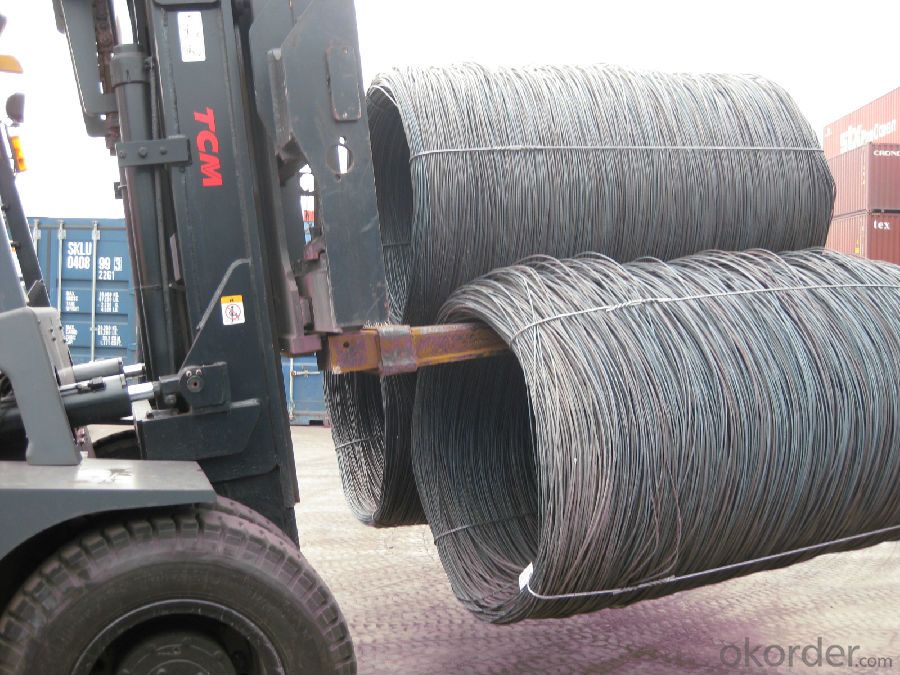
FAQ of SAE1006Cr Carbon Steel Wire Rod 12.5mm for Welding:
Q1: Why buy Materials & Equipment from OKorder.com?
A1: All products offered byOKorder.com are carefully selected from China's most reliable manufacturing enterprises. Through its ISO certifications, OKorder.com adheres to the highest standards and a commitment to supply chain safety and customer satisfaction.
Q2: How do we guarantee the quality of our products?
A2: We have established an advanced quality management system which conducts strict quality tests at every step, from raw materials to the final product. At the same time, we provide extensive follow-up service assurances as required.
Q3: How soon can we receive the product after purchase?
A3: Within three days of placing an order, we will begin production. The specific shipping date is dependent upon international and government factors, but is typically 7 to 10 workdays.
Q4: What makes stainless steel stainless?
A4: Stainless steel must contain at least 10.5 % chromium. It is this element that reacts with the oxygen in the air to form a complex chrome-oxide surface layer that is invisible but strong enough to prevent further oxygen from "staining" (rusting) the surface. Higher levels of chromium and the addition of other alloying elements such as nickel and molybdenum enhance this surface layer and improve the corrosion resistance of the stainless material.
Q5: Can stainless steel rust?
A5: Stainless does not "rust" as you think of regular steel rusting with a red oxide on the surface that flakes off. If you see red rust it is probably due to some iron particles that have contaminated the surface of the stainless steel and it is these iron particles that are rusting. Look at the source of the rusting and see if you can remove it from the surface.
- Q: How is steel wire rod used in the production of wire mesh reinforcement?
- Steel wire rod is an essential component in the production of wire mesh reinforcement. It serves as the main raw material for manufacturing wire mesh, which is widely used in construction and other industries for reinforcing concrete structures. To produce wire mesh reinforcement, steel wire rod is first processed through a series of manufacturing steps. The rod is typically drawn through a series of dies to reduce its diameter and increase its length. This process, known as wire drawing, results in a thinner and longer wire with improved mechanical properties. The drawn wire is then fed into a specialized machine called a wire mesh welding machine. This machine uses electric resistance welding to join the wires together, forming a grid-like pattern. The welding process ensures that the wires are securely bonded at their intersections, creating a sturdy and durable wire mesh. The wire mesh reinforcement is used in various construction applications, such as in the construction of concrete slabs, walls, and columns. It is embedded in concrete structures to provide additional strength, prevent cracking, and increase the overall load-bearing capacity. The wire mesh acts as a reinforcement, distributing the forces and stresses evenly across the concrete, thereby enhancing its structural integrity. Furthermore, wire mesh reinforcement is also utilized in other industries, including agriculture, mining, and manufacturing. In agriculture, it is commonly used as fencing to secure livestock and crops. In mining, wire mesh is employed for safety purposes, such as preventing rockfalls and supporting tunnel walls. In manufacturing, wire mesh is utilized for filtration, separation, and containment purposes, among others. In summary, steel wire rod plays a crucial role in the production of wire mesh reinforcement. Its transformation through wire drawing and subsequent welding forms the basis for creating durable and versatile wire mesh. This reinforcement is widely used in construction and other industries to enhance the strength and integrity of various structures.
- Q: How are steel wire rods used in the production of wire ropes for ships?
- Steel wire rods are of utmost importance in manufacturing wire ropes for ships. These rods serve as the primary material for producing wire ropes. To begin with, steel wire rods undergo a series of processes to convert them into wire strands. This entails drawing the rods through multiple dies to decrease their diameter and increase their length. This process ultimately forms thin and elongated wire strands. Subsequently, these wire strands are twisted together to form a cable core. The number of strands used and the direction of the twist depend on the specific requirements of the wire rope. This cable core provides the foundation and strength for the wire rope. Once the cable core is established, it is typically enveloped with an outer layer known as the wire rope's outer strands. These outer strands are also produced using steel wire rods. They are twisted around the cable core in a specific pattern to ensure strength, flexibility, and durability. The utilization of steel wire rods in manufacturing wire ropes for ships is crucial due to the exceptional properties of the material. Steel is renowned for its high tensile strength, resistance to corrosion, and durability, making it an ideal choice for maritime applications. These characteristics enable wire ropes made from steel wire rods to withstand the extreme forces and harsh environments encountered at sea. In conclusion, steel wire rods play a vital role in the production of wire ropes for ships. These rods are transformed into wire strands, which are then twisted together to create the cable core. The cable core is further encased with outer strands, resulting in a robust and resilient wire rope capable of enduring the demanding conditions of maritime operations.
- Q: How is steel wire rod tested for fatigue strength?
- Steel wire rod is tested for fatigue strength through a process called fatigue testing. This involves subjecting the wire rod to repeated cycles of stress, simulating real-world conditions. The wire rod is loaded with a specific stress level and then subjected to a predetermined number of cycles until failure occurs. The number of cycles endured before failure is measured, providing an indication of the wire rod's fatigue strength.
- Q: How is steel wire rod used in the manufacturing of staples?
- Steel wire rods are an essential component in the manufacturing of staples. These wire rods are typically made from high-quality steel and are available in various diameters. The process of manufacturing staples begins with the steel wire rods being coiled and then drawn through a series of dies to reduce their diameter and increase their length. This drawing process not only enhances the strength of the wire but also ensures its uniformity. Once the desired wire diameter is achieved, the steel wire is cut into smaller lengths, which will determine the size of the staples being produced. These wire lengths are then fed into a specialized staple manufacturing machine, where they undergo a series of operations. Firstly, the wire is fed into a machine that straightens and cleans it to remove any impurities or irregularities. The straightened wire is then cut and shaped into individual staple blanks. These blanks are further processed using a combination of bending, cutting, and shaping operations to form the distinctive "U" shape of the staple legs. Next, the legs of the staples are clinched or bent inwards to create the necessary tension for them to hold papers or other materials together. This process is typically performed using a clinching machine, which applies the necessary force to bend the legs inward, creating the final staple shape. Finally, the manufactured staples undergo a quality control check to ensure that they meet the required standards in terms of dimensions, strength, and overall quality. This may involve checking for proper leg length, uniformity of shape, and testing the staples' ability to hold materials securely. In summary, steel wire rods play a crucial role in the manufacturing of staples by providing the high-strength material necessary for securely holding papers or other materials together. Through a series of processes, the wire rods are transformed into the distinctive "U" shape of staples, ensuring their functionality and reliability for various applications.
- Q: How is the mechanical strength of steel wire rod assessed?
- The mechanical strength of steel wire rod is assessed through various testing methods. One common method is tensile testing, where a sample of the wire rod is subjected to tension until it breaks. This test measures the maximum amount of force the wire rod can withstand before failure, known as the ultimate tensile strength. Another important parameter assessed is the yield strength, which is the maximum amount of stress the wire rod can undergo without permanent deformation. Other tests include hardness testing, which measures the resistance of the wire rod's surface to indentation or scratching. This is done using methods such as the Rockwell or Brinell hardness tests. Another important aspect to consider is the ductility of the wire rod, which is its ability to deform under tensile stress without fracturing. This is typically evaluated through elongation and reduction of area measurements. Additionally, the steel wire rod's toughness, which is its ability to absorb energy before fracturing, is assessed through impact testing. This test involves striking the wire rod with a pendulum or a falling weight to measure the energy absorbed during fracture. All these testing methods help evaluate the mechanical strength of steel wire rod, ensuring its suitability for various applications such as construction, automotive, or manufacturing industries.
- Q: What are the major suppliers of steel wire rod?
- Some of the major suppliers of steel wire rod include ArcelorMittal, Nippon Steel Corporation, POSCO, Tata Steel, and Baosteel Group.
- Q: How is steel wire rod used in the manufacturing of wire for power generation systems?
- Steel wire rod is an essential raw material used in the manufacturing of wire for power generation systems. It serves as the primary material for producing high-quality power transmission and distribution cables, which are crucial in transmitting electricity from power plants to various destinations. The manufacturing process starts with steel wire rod being carefully selected for its specific properties, including strength, durability, and conductivity. The rod is then heated to the appropriate temperature and passed through a series of dies to shape it into the desired wire diameter. This process, known as wire drawing, involves reducing the diameter of the rod while increasing its length. Once the wire has been drawn to the required size, it undergoes a series of treatments to improve its mechanical properties. This may include processes such as annealing, where the wire is heated and slowly cooled to relieve internal stresses and enhance its flexibility and ductility. Additionally, the wire may undergo galvanization, where a protective layer of zinc is applied to prevent corrosion and improve its longevity. The manufactured wire is then used in the construction of power transmission and distribution cables. These cables play a vital role in delivering electricity efficiently and safely over long distances. The steel wire provides the necessary strength and tensile properties to support the weight of the cables and withstand the mechanical stresses during installation and operation. It also ensures the cables maintain their shape and structure under the influence of external forces such as wind, ice, and temperature variations. Furthermore, the steel wire's electrical conductivity allows for efficient transmission of electricity, reducing power losses during transmission. This property is crucial in power generation systems, where minimizing energy losses is essential to ensure the effective and economical delivery of electricity. In conclusion, steel wire rod is a critical component in the manufacturing of wire for power generation systems. It provides the necessary mechanical strength, durability, and electrical conductivity required for power transmission and distribution cables. By enabling efficient and reliable electricity transmission, steel wire plays a vital role in powering our homes, businesses, and industries.
- Q: What are the standard straightness requirements for steel wire rod?
- The standard straightness requirements for steel wire rod are typically specified by industry standards or customer specifications. These requirements ensure that the wire rod has a straight and uniform shape, which is crucial for its intended applications. One common straightness requirement for steel wire rod is the maximum allowable deviation from a straight line. This is usually specified as a maximum bow or camber, which refers to the amount of deviation from a straight line when the wire rod is laid flat on a surface. This requirement ensures that the wire rod can be easily processed and used in various manufacturing processes, such as drawing, cold heading, or welding. Another straightness requirement for steel wire rod is the maximum permissible twist or helix. This refers to the amount of rotation or spiral distortion along the length of the wire rod. Excessive twist can affect the wire rod's performance, especially in applications where it needs to be threaded through tight spaces or used in precision machinery. In addition to these primary straightness requirements, there may be specific tolerances for straightness at different sections or lengths of the wire rod. For example, the straightness requirement may be more stringent at the ends or along specific portions of the wire rod. These variations in straightness requirements are often determined based on the wire rod's intended application or the customer's specific needs. Overall, the standard straightness requirements for steel wire rod aim to ensure that the product meets the necessary quality standards and can be effectively used in various manufacturing processes. Compliance with these requirements helps to guarantee that the wire rod performs reliably and consistently in its intended applications.
- Q: What are the common steel wire rod manufacturing processes?
- The common steel wire rod manufacturing processes typically involve several steps to transform raw materials into high-quality steel wire rods. The process can vary slightly depending on the specific requirements and desired properties of the wire rod, but the general steps remain consistent. 1. Raw material preparation: The manufacturing process begins with the selection of high-quality raw materials, usually in the form of billets or bars. These materials are carefully inspected and tested to ensure they meet the necessary specifications for strength, composition, and size. 2. Heating: The selected raw materials are heated in a furnace to a specific temperature to make them more malleable and easier to work with. This process is known as heating or preheating. 3. Rolling: The heated billets or bars are then passed through a series of rolling mills to reduce their size and shape them into wire rod form. The rolling process involves a combination of hot rolling, cold rolling, or both, depending on the desired properties and dimensions of the wire rod. 4. Descaling: After the rolling process, the wire rod is often covered with scales or oxides that need to be removed. Descaling is carried out using various methods, such as acid pickling, shot blasting, or mechanical descaling, to ensure a clean surface finish. 5. Cooling: Once the wire rod has been shaped and descaled, it is cooled either naturally or through the use of water sprays or air cooling systems. Cooling is essential to strengthen the wire rod and improve its mechanical properties. 6. Surface treatment: Depending on the intended application, the wire rod may undergo additional surface treatments such as galvanization, coating, or heat treatment to enhance its corrosion resistance, appearance, or other specific properties. 7. Testing and quality control: Throughout the manufacturing process, the wire rod undergoes various quality control checks and testing procedures to ensure it meets the required standards. These include checks for dimensions, tensile strength, surface defects, and other mechanical and chemical properties. 8. Packaging and storage: Once the wire rod has passed all quality control tests, it is typically packaged and stored in a controlled environment to prevent any damage or contamination. Proper packaging and storage ensure that the wire rod remains in excellent condition until it is ready for shipment or further processing. Overall, the common steel wire rod manufacturing processes focus on transforming raw materials into high-quality wire rods by heating, rolling, descaling, cooling, surface treatment, and rigorous quality control measures. These processes are crucial to producing wire rods with the desired mechanical properties, dimensions, and surface finishes for various industrial applications.
- Q: What are the key success factors for companies in the steel wire rod industry?
- The key success factors for companies in the steel wire rod industry include efficient production processes, high-quality products, strong supply chain management, competitive pricing, effective marketing and sales strategies, and the ability to adapt to changing market conditions. Additionally, maintaining strong relationships with customers and suppliers, investing in research and development to innovate and improve products, and ensuring compliance with industry regulations are also crucial for success in this industry.
Send your message to us
SAE1006Cr Carbon Steel Wire Rod 12.5mm for Welding
- Loading Port:
- Shanghai
- Payment Terms:
- TT OR LC
- Min Order Qty:
- 100 m.t
- Supply Capability:
- 30000 m.t/month
OKorder Service Pledge
OKorder Financial Service
Similar products
Hot products
Hot Searches
Related keywords
